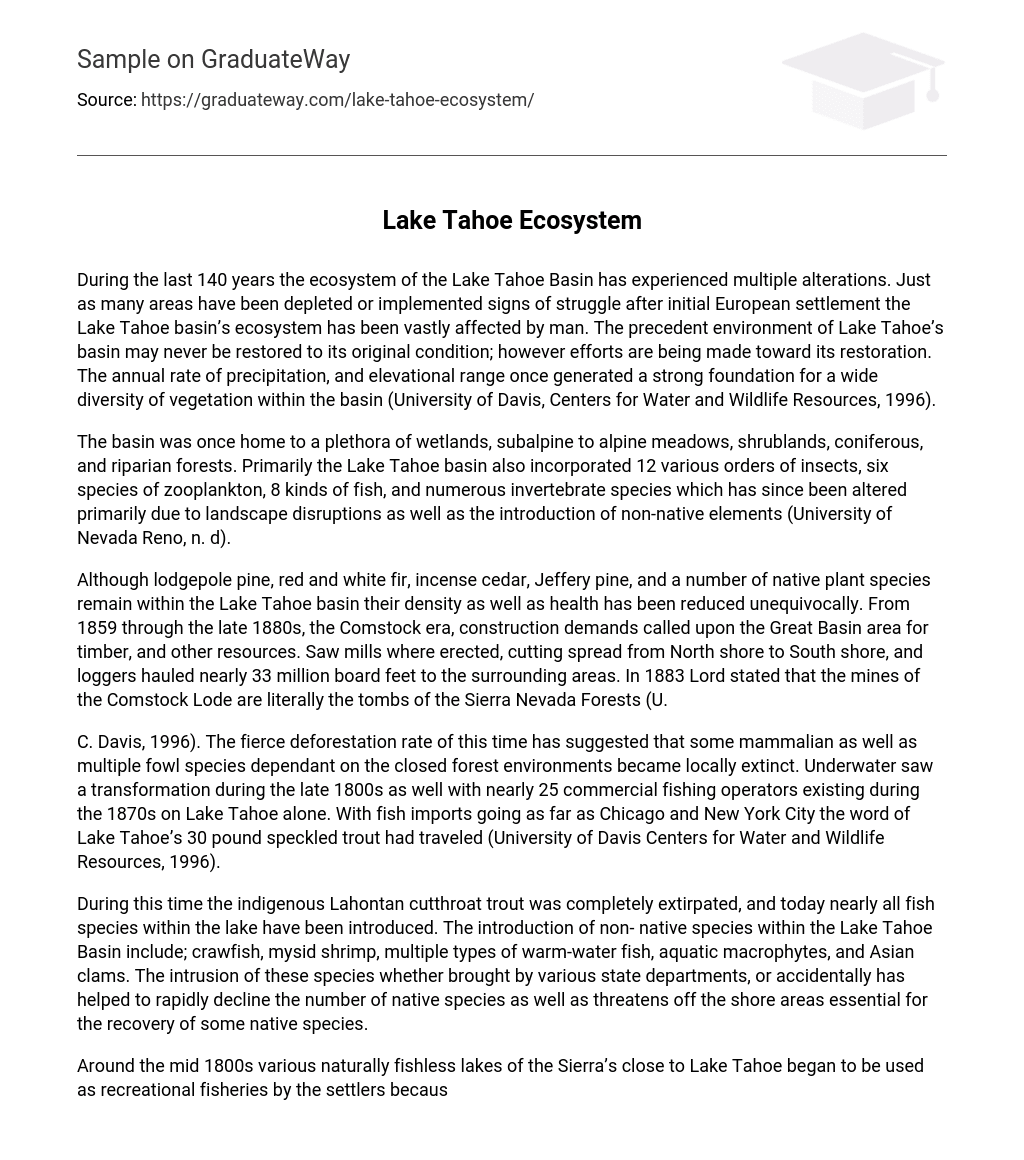The ecosystem of the Lake Tahoe Basin has experienced significant changes over the last 140 years due to human activities associated with European settlement. Although complete restoration of the original condition may not be achievable, efforts are underway to restore it. The basin’s previous environment, which included varying elevations and an annual precipitation rate, supported a diverse range of vegetation (University of Davis, Centers for Water and Wildlife Resources, 1996).
The natural habitats in the Lake Tahoe basin, such as wetlands, meadows, shrublands, forests, and riparian areas used to be diverse. They supported a variety of wildlife including 12 insect orders, six zooplankton species, eight fish species, and many invertebrates. However, the landscape changes and introduction of non-native elements have significantly altered these ecosystems (University of Nevada Reno, n. d).
Although lodgepole pine, red and white fir, incense cedar, Jeffery pine, and several native plant species still exist in the Lake Tahoe basin, their density and health have unquestionably been reduced. During the Comstock era, from 1859 to the late 1880s, the construction demands of the Great Basin area resulted in the exploitation of timber and other resources. Saw mills were erected and logging spread from the North shore to the South shore, resulting in the transportation of nearly 33 million board feet to surrounding areas. In 1883, Lord declared that the mines of the Comstock Lode were essentially the graves of the Sierra Nevada Forests (U.
C. Davis, 1996). The rapid deforestation rate during this period led to the local extinction of several mammalian and avian species that relied on closed forest environments. Furthermore, in the late 1800s, the underwater environment also underwent changes, with Lake Tahoe alone hosting around 25 commercial fishing operators by the 1870s. The reputation of Lake Tahoe’s 30 pound speckled trout spread as far as Chicago and New York City, with fish imports reaching these cities (University of Davis Centers for Water and Wildlife Resources, 1996).
The indigenous Lahontan cutthroat trout was completely eradicated during this period, and currently, almost all fish species in the lake are not native. Non-native species introduced in the Lake Tahoe Basin include crawfish, mysid shrimp, various warm-water fish species, aquatic macrophytes, and Asian clams. The presence of these species, whether intentionally introduced by state departments or accidentally, has greatly reduced the population of native species and poses a threat to the recovery of certain native species and their shoreline habitats.
Around the mid 1800s, settlers started using naturally fishless lakes in the Sierra’s near Lake Tahoe for recreation due to depleted native fish stocks and excessive fishing. After attempts by Euro-American settlers to replenish Lake Tahoe, California’s Fish and Game Department took over the project of restocking the lake. This was done through horseback transportation and air dropping of fish into nearby lakes (The Mountain Yellow-legged Frog Site, n. d.).
The introduction of different non-native trout species in fishless lakes has had both positive and negative effects on the native species. The presence of multiple non-native species in Lake Tahoe has led to negative consequences for the lake and its ecosystem. Originally introduced as a source of food for warm water fish like crawfish and mysid shrimp, these non-native species have caused pollution and disturbance to the natural transparency of Tahoe’s waters, along with a decline in the zooplankton community.
Scientists from www.tahoescience.org have reported that the crawfish population in the lake is thriving due to various factors. An increase in other food sources for non-native fish species has potentially contributed to the rise in crawfish numbers. Moreover, the natural release of phosphorous and nitrogen by crawfish has led to a faster turnover rate in the lake’s waters, thanks to their abundant population (University of Davis Centers for Water and Wildlife Resources, 1996).
Due to rising temperatures, warm-water fish that are not native to the Lake Tahoe area have thrived in its waters. This temperature increase is likely caused by higher algae production near the shore, which is fueled by nutrients from Asian clams. These same nutrients also support the increasing population of crawfish. In the past, human activity in the Lake Tahoe Basin has involved deforestation and the elimination of much of its natural aquatic life.
Despite the negative impact caused by its founder’s excessive consumption and greed, the Lake Tahoe area has potential for recovery. Efforts have been made by various departments to establish fish hatcheries in the region and replenish native fish species. Additionally, fish have been taken from nearby lakes. The large portions of national forest land surrounding the area also offer opportunities for timber regeneration. Over time, we continue to acquire more knowledge about the environmental damage caused by those who came before us, enabling us to actively work towards reversing it.





